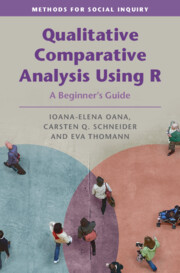2 - Calibrating and Combining Sets
Published online by Cambridge University Press: 07 October 2021
Summary
When using QCA, we conceive of social phenomena as sets in which the cases have membership, and we look at social phenomena as complex combinations of different sets. For example, to allocate students to the set of ‘good students’, we need to define clear criteria for distinguishing ‘good’ from ‘not good’ students, and think about how different criteria combine to indicate that a student is ‘good’.
We first discuss how to attribute cases to sets: types of sets and ways to measure them, approaches to calibrating sets, and their implementation in R. We introduce good practices, practical tips, and some diagnostic tools for calibration. Second, we discuss how to combine sets with the Boolean operations AND, OR, and NOT. These techniques help us conceptualize social phenomena, including useful rules for combining and presenting set-theoretic expressions.
Learning goals:
- Basic understanding of the notion of calibration and different calibration techniques.
- Familiarity with good practices and diagnostic tools for set calibration.
- Familiarity with basic Boolean operations on sets and the rules for attributing cases to combined sets.
- Familiarity with different techniques of aggregating sets into higher-order concepts.
- Ability to implement these calibration and concept formation tools in R.
Keywords
- Type
- Chapter
- Information
- Qualitative Comparative Analysis Using RA Beginner's Guide, pp. 27 - 60Publisher: Cambridge University PressPrint publication year: 2021
- 1
- Cited by

